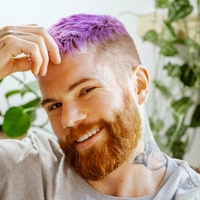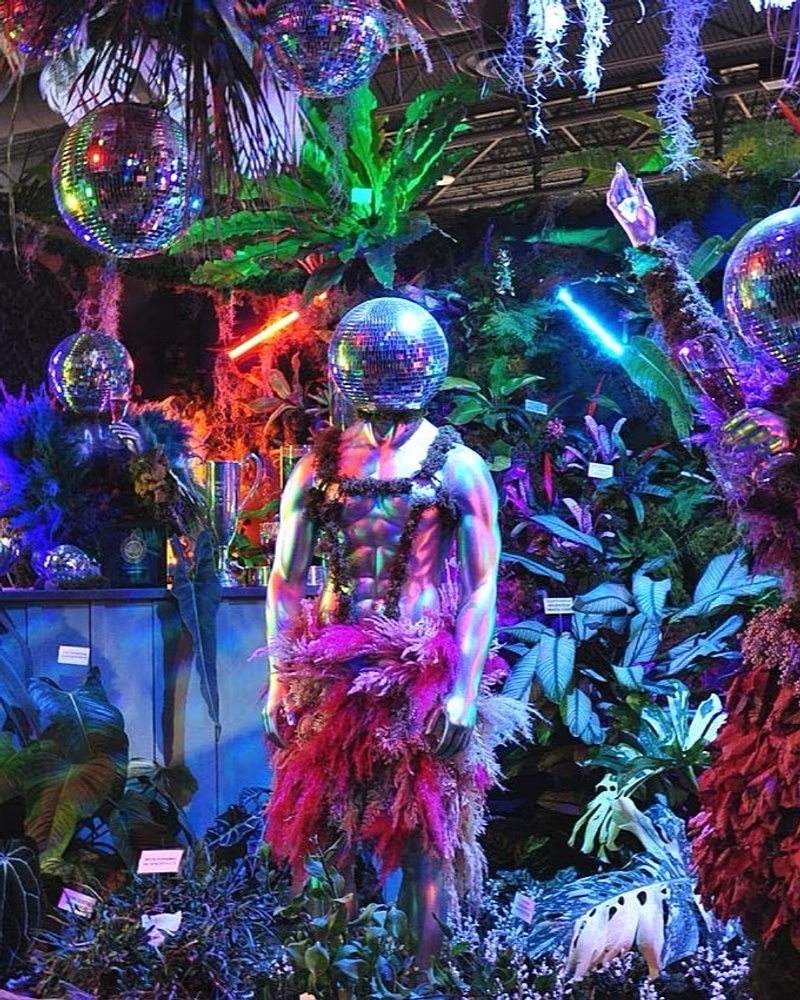As told to Max Freedman, 2525 words.
Tags: Performance, Art, Beginnings, Collaboration, First attempts, Identity, Mental health.
On doing what it takes to bring your ideas to life
Performance artist Gunnar Montana discusses learning new things to independently fulfill your creative vision while being open to organic collaboration.You do a lot of set-building, choreography, and other things within your art. How did you learn to do so much?
I’m a jack of many trades, and it comes with the desire to learn. The most fun part of making art, to me, is figuring out how to do new things and then accomplishing them. That can be a dance show, a flower installation. Right now, I just got done building a vivarium stand and a frog vivarium. It’s whatever comes along. I get really intrigued by the process of it all. It’s about the journey.
How did you realize you wanted to learn so many things? How did you realize you would do so much of it yourself, and so many different things yourself, rather than outsourcing?
It came by default. Theater is so hard to make, especially right now, that a lot of stuff won’t get done unless you do it yourself. I started learning all this stuff because I didn’t feel like other people were going to do it for me the way I wanted it to be done. It’s stressful, and it’s exhausting in a lot of different ways. If you have a clear vision, getting people as a grassroots artist, and having the resources to get the people to pull off the vision you want, can be very hard. It can be very daunting. So I started doing everything myself, and now, that’s what I do.
You used the word “theater.” Do you consider theater the through-line of everything you do?
Everything feels very theatrical. We’re about to walk through my Philadelphia Flower Show exhibit, and this is going to be very theatrical. I think there’s a theatricality to me as a person that shines through in my work. It’s very over the top. It’s very excessive, massive, big, smoke and mirrors and all of that stuff. I’m just that kind of person, so that’s what you get.
Where does collaboration come into the picture for you? Despite everything you’re saying, you didn’t do this entirely yourself.
Lately, because I’ve been getting older and more exhausted by life, I’ve been delegating more of my work and looking for more creative minds to collaborate with to take off the load and stress that a massive theater production can be. I started looking for people who are doing things better than I am, or better than I could, because I don’t have the bandwidth to focus on everything and be the best at everything. I started looking into lighting designers who are queer-focused, who have the same mentality as me, and set designers who get the vision.
It can be hard to find these people, and I like to find them organically. I like people to come into my life and want to work with me and be a part of what I’m creating, and not necessarily to do it for the money or the work of it. I want them to enjoy it and be passionate about it.
How important is it to work with queer people for you? Is it exclusively that you work with other queer people, or is it just a majority thing?
I’m very queer, I’m very gay, as much as I am not. I think as a community, we tend to zone in on our queerness and make that a big part of our personality, and I kind of go 50/50 with it. I feel very two-spirited in that way. I have a more straight persona that’s all DeWalt tools and a buzz cut, and then I have a very queer persona that’s dresses, heels, bright colors, and neon lights, and I kind of bounce between the two, and I like to incorporate it as much as possible. The queer voice needs to be loud, especially right now, so I don’t mind amplifying that, but it’s not 100% of who I am or how I work.
Between your online presence and sponsorships, and the shows you’ve done in person, such as BATH HOUSE, how have you figured out how to make a living through your creativity?
It’s hard, and I think doing so much and being so able to do so many things works in my favor. [During the early pandemic], for instance, I wasn’t able to perform live, so I started painting, making murals, and selling paintings. I dabble in whatever keeps me afloat, and when I find something that keeps me afloat, I really learn how to do it and get good at it, and then I utilize that whenever I need to.
It’s not easy, especially nowadays since everybody wants you to have a niche and fit into that. They want your Instagram posts to be very similar. They want you to be what they want you to be, in a very structured way. And because my work is so all over the place, people can’t pinpoint what I do. They don’t know if I’m a visual artist. They don’t know if I’m a theater artist. They don’t know if I’m an immersive installation artist.
How much of this being elusive and diverse is intentional versus a product of how you operate?
I really wish I could settle down on something. I really wish I could just be one thing. It would be a lot easier just to focus, but it’s not my personality. I don’t sit still that long, and I get bored very quickly, so I keep moving from one thing to the next, and they keep stacking up on top of each other in this snowball effect that you could call my career.
What emotions, what doubts or feelings of success, can come with learning something new for the first time?
Just the idea of creation, the idea of giving birth to something, is a success to me. The hardest thing about making art is to get it out on paper, to make it reality. A lot of people are very creative in their heads. It’s about executing that idea and making that come to life, which can be extremely difficult, so if I have an idea and it comes to life, that’s a success for me.
That can be flowers. That can be an art show. That can be a type of dance I’m trying to portray. That can be an emotion in a dance I’m trying to get out of people, all of that stuff. It’s just from point A to point B, because a lot of people stop at point A and don’t know how to get to point B.
How do you find inspiration for the things you create?
My process is very organic, so whatever happens to me that year ends up in a show. Whoever comes up to me and says, “I want to collaborate with you,” I end up collaborating with. I call it being palms-up to the universe and guided by whatever happens. There isn’t a deadline, there isn’t a great success for me. Things just happen organically, and I try my best in the moment to make the best things I possibly can.
How did you realize you were going to be an artist?
I don’t think there was a realization. I think it just was. It was just a passion I’ve had to create since the get-go. I came out of the womb and was ready to just make, and that’s the purpose. That’s why I’m here. When I realized that’s why I was here, and that’s really the only reason I’m living, I made that my end goal. There wasn’t an epiphany there. It’s like queerness. You always are.
Do you ever face burnout given how much you have to do to make a living or execute your vision?
All the time. I’m burnt out all the time, and I’m constantly navigating that burnout. COVID changed things. We’re all more attuned to burning out because we’ve been doing it for so long and it’s been normal. But it is a constant struggle.
Nobody ever sees the not-glamorous side of making art. Everybody sees the final product. Everybody sees the show when it’s being performed or the installation when it’s up, but you don’t see all the hard work that goes into it, all the tedious stuff, all the breakdowns you have and the crying at home. And there’s so much of that. It’s so important to take care of yourself through your work.
I will take weeks off. Whatever I do, I’ll make sure that I come first, because that’s how you get the best work. You’re your best creator when you’re taking care of yourself. That can mean a lot of things. That can mean going on vacation. That can mean not making art and not being an artist for a while. That can mean taking care of other things outside of your art or thinking outside your brand so you don’t get so focused and have such tunnel vision in a narcissistic way. Or that can mean going to the gym every day, which I do, and getting it out that way.
What are some other things that aren’t as glamorous behind the scenes that come with making art?
The physical side is, you see this beautiful flower show right now? It’s amazing. And for the next three days, I’ll be ripping this down from 6:00 to 12:00 every day. That means shoveling mulch out of it. That means moving cinder blocks. That means taking walls apart and moving walls that are 50 pounds each, and doing that for 72 hours straight.
Then, there’s the emotional part where you create this thing, and everybody experiences it and loves it, and then the next day, it’s gone. What you’ve created is dead, and you have to get used to the idea that these are fleeting thoughts, these are fleeting creations, and nothing lasts.
It can be hard to grapple [with] working on something and making something so beautifully from scratch, and then having it gone in 24 hours. I can fall into really deep depressions about it because you lose, almost, a loved one. I’ll spend a year making a show, and the night it closes, it’s gone. It’s done. And only the people that saw it get to experience it. That’s the mental part that a lot of people don’t understand. You’re constantly creating, and [your creations are] constantly being destroyed.
There’s something really traumatizing about building something and then taking it apart by yourself and destroying it. But there’s also something cathartic in that, because you’re constantly doing it in life. You’re doing it with your relationships. People are dying around you in life, and you have to deal with all of this trauma. It’s nice to be able to navigate that.
There was something you said earlier about branding. How much do you feel like, these days at least, branding is part of being a creative?
It’s important to have a brand. I try not to focus on it too much, because you can get very absorbed in it, and it can be a bigger part of you than the art. Your brand can become more important than what you’re actually doing in real-time. I like to have the brand as a secondary thought. I always like the work to come first and speak for itself outside my brand. But stamping your name on everything and making sure what you’re doing is up to par with what you’ve been doing is very important to me. I always want it to be really fantastic and to the best of my ability if it’s coming from Gunnar Montana.
How do you know something you’re working on is finished?
A lot of the time, I don’t. Especially when I’m working on a dance show, it’s never finished. I’ll give my dancers notes on their last performance as to what they could do better.
One of the horrible things about being an artist can be that you’re so self-critical, and I am to a fault. But that can also be really amazing because you keep challenging yourself and you’re never comfortable with what you’ve created. A lot of times, I don’t enjoy what I created because I always see the flaws in it and what I could be doing better.
Every once in a while, I’ll be like, “I did that to my best ability, and while it could be better in a few ways, I think that’s where I’m at right now.” There have been very few where I’ve been like, “That, I couldn’t produce again, or that was special for what it was, and that was finished for what it was.” The ILLExotics mural is one of the few things I go up to every day and be like, “How did I do that?” Which is a really fun feeling, but it doesn’t come very often. More so than not, I’m not happy with what I make.
How do you edit your work?
Art goes both ways. A lot of people don’t like to think this, because they like to think artists can be in their own world and create whatever they want, but it’s a relationship with the people viewing it. You have to think about that relationship.
I’ll present an idea or a project to my partner, and his reaction alone is so authentic and real that I’ll know right away whether it’s good or not. We have such a great relationship that he isn’t afraid to tell me when I could have done better.
I gauge how my work is taken in by other people. For the first week of a dance show, I’ll watch the audience and see their reactions to different moments, and then I’ll tweak the show based on that.
It’s really important to have somebody in your corner who’s willing to give you constructive criticism in a way that doesn’t hurt your feelings or cause you to overly question.
Absolutely. You have to have a really tough skin and realize you’re not god’s gift to the art world, or any world for that matter, and that you can always do better and be criticized for your work. You have to find people in your life that you have a healthy relationship like that with.
I have lost a lot of friends because my idea of friendship is to critique people into the best version of themselves. I have learned how to do that more gracefully than when I started. It’s a learning process, and you have to be open to that. You have to make sure you’re coming from a humble enough place for that not to affect your ego.
Gunnar Montana Recommends:
Here are my five scary movie recommendations
Hereditary
The Shining
X
Mother!
The Witch






